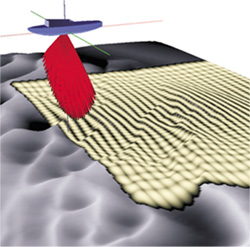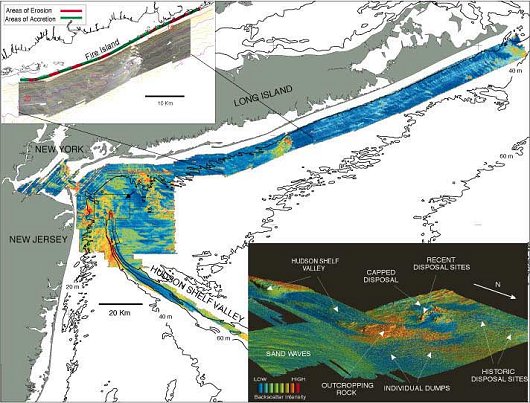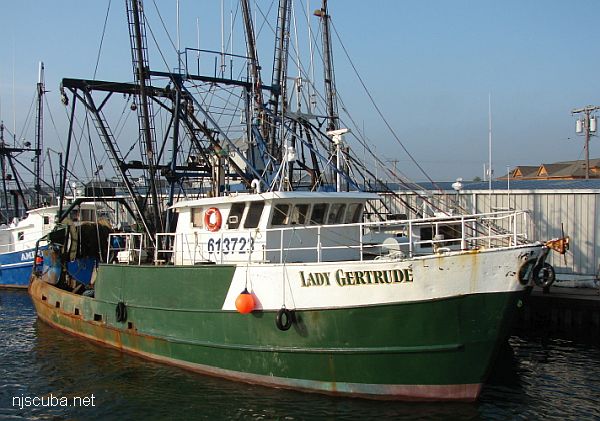Side-scan Sonar (3/3)

Mapping the Sea Floor Geology Offshore of the New York-New Jersey Metropolitan Area
Introduction
The U.S. Geological Survey (USGS) is mapping the seafloor offshore of major metropolitan centers. The New York-New Jersey metropolitan area is one of the most populated coastal regions in the United States. The New York harbor estuary and its offshore area are used for waste disposal, transportation, recreation, and commercial and recreational fishing.
Interpretive maps of the sea-floor geology provide a fundamental framework for research and management in the coastal ocean. They show the composition of the seabed and the shape (topography) of the seafloor; they also show areas of present and past dumping of sediments and pollutants, as well as locations and impacts of other human activities. They provide information on the transport of sediment and help to define biological habitats. All this information can be used to develop predictive models to guide habitat and resource management, monitoring strategies, and other research studies.
Mapping the Sea Floor
Modern oceanographic surveys use remote-sensing techniques (side-scan sonar (fig. 1), multibeam echo sounding (fig. 2), and high-resolution seismic-reflection profiling), direct sampling, and visual observations to characterize the seafloor. The surveys provide a new, highly detailed view of the seafloor. In contrast to earlier maps that were based on widely spaced data, the new digital images are similar in detail to an aerial photograph and show the changes in seabed features over a wide range of scales. The locations and effects of human activities, such as waste disposal and bottom trawling, are often clearly observed. Sedimentary features, such as bedforms, provide information about the transport and fate of sediments and pollutants and about the importance of the underlying geologic structures and the geologic history in controlling the present distribution of surface sediments.

Upper:
A side-scan sonar "fish" towed behind a vessel surveys the seafloor by sending sound to either side of the ship's path. Typical survey swaths (yellow area) are a few hundred meters wide.
Lower:
The intensity and pattern of sound reflected from the ocean floor provide information on the composition of sediments and the topography. Strong reflections from boulders, gravel, and the walls of trawl grooves appear as light tones on this data record; weak reflections from finer sediments or shadows behind vertical features are dark. A composite image, pieced together from multiple survey strips, provides an image of the seafloor similar in detail to an aerial photograph.

High-resolution multibeam mapping systems use sound from arrays of 60 to more than 150 electronically separated transducers to measure water depth as well as sediment characteristics of the seafloor. The transducers form beams a few degrees wide that produce a footprint of a few square meters on the seafloor in water depths of 50 meters. Because the system is fixed to the ship's hull, the data can be easily georeferenced and surveys can be run at speeds of 15 knots. The multibeam surveys provide a new, highly detailed view of the seafloor. Used with the permission of the University of New Brunswick.
Mapping the Area Offshore of New York and New Jersey
Sidescan sonar and multibeam systems emit pulses of sound that reflect off the seafloor. Features of the seafloor are identified by the pattern and varying levels of sound reflected (backscattered) from the seafloor. One of the most striking characteristics of the backscatter maps of the New York Bight area (fig. 3) is the variability in sediment characteristics over scales of tens to hundreds of meters. Sampling, bottom photography, and the high-resolution seismic observations show that the bottom sedimentary environments in this area range from outcropping rock to muds. The maps show a complex pattern of sediment properties that is a result of the underlying geology, modern processes, and anthropogenic activities.

The USGS has mapped the seafloor in the New York Bight apex and along the southern shore of Long Island by using side-scan sonar, and the Hudson Shelf valley and adjacent shelf by using multibeam. This combined backscatter image (red is high backscatter and blue is low backscatter) shows a complex pattern of sediment properties that is a result of the underlying geology, modern processes, and anthropogenic activity. The backscatter intensity is related to sediment texture, as well as other properties. In general, high backscatter indicates coarse-grained sediment or outcropping rock, and low backscatter indicates fine sands, silt, or clays. The Hudson Shelf valley is floored with fine-grained sediments. The box outlines the location of the multibeam image shown at right; the black arrow indicates the look direction -- to the southwest. From Schwab and others (1997); Butman and others (1998).
Top left:
Along the southern shore of Long Island, Cretaceous age (>65 million years old) rocks outcrop approximately 6 kilometers off central Fire Island (bright high-backscatter region) and exert a primary control on observed patterns of coastal change. This area acted as a headland during times of lower sea level about 10,000 years ago. Erosion of this headland during subsequent sea-level rise furnished sediments to the inner shelf downdrift to the west. These sediments, in turn, were reworked by oceanographic processes into a series of sand ridges. Note the halo of coarser sediment to the west of the outcropping rock. A westward and onshore sediment flux from these ridges may supply sediment to the beaches of western Fire Island and may influence the pattern of erosion of the barrier-island system. From W.C. Schwab and others, written community. (1998).
Lower right:
Sun-illuminated perspective view (looking to the southwest) of the topography and sediment characteristics of the shelf at the head of the Hudson Shelf valley (area in box, fig. 3). The image was constructed by draping color-coded backscatter intensity over the bathymetry, as measured by a multibeam system. Water depth at the northern portion of the region is approximately 30 meters; water depth in the Hudson Shelf valley at the left of the image is about 50 meters. Features observed include relatively smooth mounds composed of material dumped since the 1800s; mounds (as high as 10 meters) of dredged material from more recent disposal; a smooth, roughly circular region that resulted from disposal of contaminated sediments and is capped with coarse sand; outcrops of southwestward-dipping Cretaceous age coastal plain strata at the head of the Hudson Shelf valley; low-relief (amplitude <1 meter) sand waves suggesting sediment transport to the southwest; and individual dumps of material, some arranged in lines, in some cases probably large rocks from construction activity in New York (referred to as "derrick stones"). From Butman and others (1998).
The surveys off the New York-New Jersey area are being carried out by the USGS in cooperation with the U.S. Army Corps of Engineers, Texas A&M University, the State University of New York at Stony Brook, the University of New Brunswick, the Canadian Hydrographic Service, Wesleyan University (Connecticut), and Coastal Carolina University.
References Cited
Butman, Bradford, Danforth, W.W., Schwab, W.C., and Bucholtz ten Brink, M.R., 1998, Seafloor topographic and backscatter maps of the Upper Hudson Shelf valley and adjacent shelf, offshore of New York: U.S. Geological Survey Open-File Report 98-616.
Schwab, W.C., Allison, M.A., Corso, W. Lotto, L.L., Butman, B., Bucholtz ten Brink, M., Denny, J., Danforth, W.W., and Foster, D.S., 1997, Initial results of high-resolution sea-floor mapping offshore of the New York - New Jersey metropolitan area using side-scan sonar: Northeastern Geology and Environmental Sciences, v. 19, no. 4, p. 243-262.
For more information, please contact:
Bradford Butman
U.S. Geological Survey
Woods Hole Field Center
384 Woods Hole Road
Woods Hole, MA 02543-1598
E-mail: bbutman@usgs.gov

